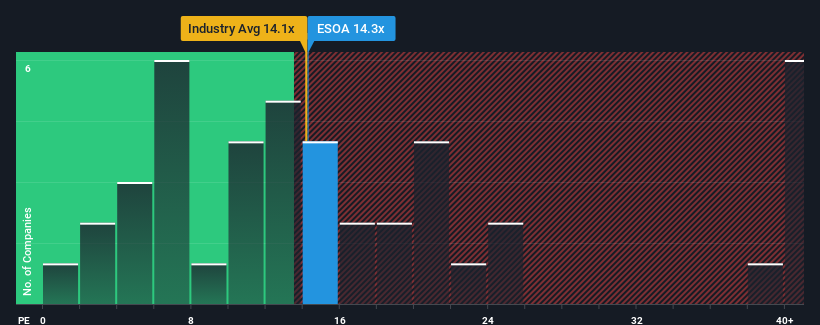- United States
- /
- Energy Services
- /
- NasdaqCM:ESOA
Energy Services of America Corporation's (NASDAQ:ESOA) Shares Lagging The Market But So Is The Business

With a price-to-earnings (or "P/E") ratio of 14.3x Energy Services of America Corporation (NASDAQ:ESOA) may be sending bullish signals at the moment, given that almost half of all companies in the United States have P/E ratios greater than 18x and even P/E's higher than 32x are not unusual. However, the P/E might be low for a reason and it requires further investigation to determine if it's justified.
With its earnings growth in positive territory compared to the declining earnings of most other companies, Energy Services of America has been doing quite well of late. One possibility is that the P/E is low because investors think the company's earnings are going to fall away like everyone else's soon. If you like the company, you'd be hoping this isn't the case so that you could potentially pick up some stock while it's out of favour.
See our latest analysis for Energy Services of America

Does Growth Match The Low P/E?
There's an inherent assumption that a company should underperform the market for P/E ratios like Energy Services of America's to be considered reasonable.
If we review the last year of earnings growth, the company posted a terrific increase of 235%. Pleasingly, EPS has also lifted 396% in aggregate from three years ago, thanks to the last 12 months of growth. Accordingly, shareholders would have probably welcomed those medium-term rates of earnings growth.
Looking ahead now, EPS is anticipated to slump, contracting by 18% during the coming year according to the sole analyst following the company. That's not great when the rest of the market is expected to grow by 12%.
In light of this, it's understandable that Energy Services of America's P/E would sit below the majority of other companies. However, shrinking earnings are unlikely to lead to a stable P/E over the longer term. Even just maintaining these prices could be difficult to achieve as the weak outlook is weighing down the shares.
The Final Word
Generally, our preference is to limit the use of the price-to-earnings ratio to establishing what the market thinks about the overall health of a company.
As we suspected, our examination of Energy Services of America's analyst forecasts revealed that its outlook for shrinking earnings is contributing to its low P/E. At this stage investors feel the potential for an improvement in earnings isn't great enough to justify a higher P/E ratio. It's hard to see the share price rising strongly in the near future under these circumstances.
We don't want to rain on the parade too much, but we did also find 4 warning signs for Energy Services of America (1 is potentially serious!) that you need to be mindful of.
If P/E ratios interest you, you may wish to see this free collection of other companies with strong earnings growth and low P/E ratios.
Valuation is complex, but we're here to simplify it.
Discover if Energy Services of America might be undervalued or overvalued with our detailed analysis, featuring fair value estimates, potential risks, dividends, insider trades, and its financial condition.
Access Free AnalysisHave feedback on this article? Concerned about the content? Get in touch with us directly. Alternatively, email editorial-team (at) simplywallst.com.
This article by Simply Wall St is general in nature. We provide commentary based on historical data and analyst forecasts only using an unbiased methodology and our articles are not intended to be financial advice. It does not constitute a recommendation to buy or sell any stock, and does not take account of your objectives, or your financial situation. We aim to bring you long-term focused analysis driven by fundamental data. Note that our analysis may not factor in the latest price-sensitive company announcements or qualitative material. Simply Wall St has no position in any stocks mentioned.
About NasdaqCM:ESOA
Energy Services of America
Operates as a contractor and service company for the natural gas, petroleum, water distribution, automotive, chemical, and power industries in the United States.
Solid track record and good value.
Market Insights
Community Narratives




